Comprehensive Report: Analyzing How Businesses Operate Effectively
VerifiedAdded on 2023/01/11
|8
|2266
|52
Report
AI Summary
This report provides a comprehensive overview of business operations, encompassing various crucial aspects. It begins by defining the core actions businesses undertake to maximize value and generate profit, highlighting essential resources such as capital, labor, and infrastructure. The report delves into the importance of accounting for business success, explaining how it aids in tracking income and expenses, ensuring compliance, and providing financial data for decision-making. It also defines the different functions of the HR department, including recruitment, training, and employee relations, and outlines key features of employment legislation. Furthermore, the report interprets information from a profit and loss account and examines team roles and development stages using Tuckman’s model. It also assesses three motivation theories – Maslow's Hierarchy of Needs, Vroom’s Expectancy Theory, and Adam’s Equity Theory – and explores different leadership styles, such as democratic, autocratic, and laissez-faire. The report concludes by emphasizing the role of various departments and concepts in ensuring effective business operations and success.

How Businesses
Operate
Operate
Paraphrase This Document
Need a fresh take? Get an instant paraphrase of this document with our AI Paraphraser
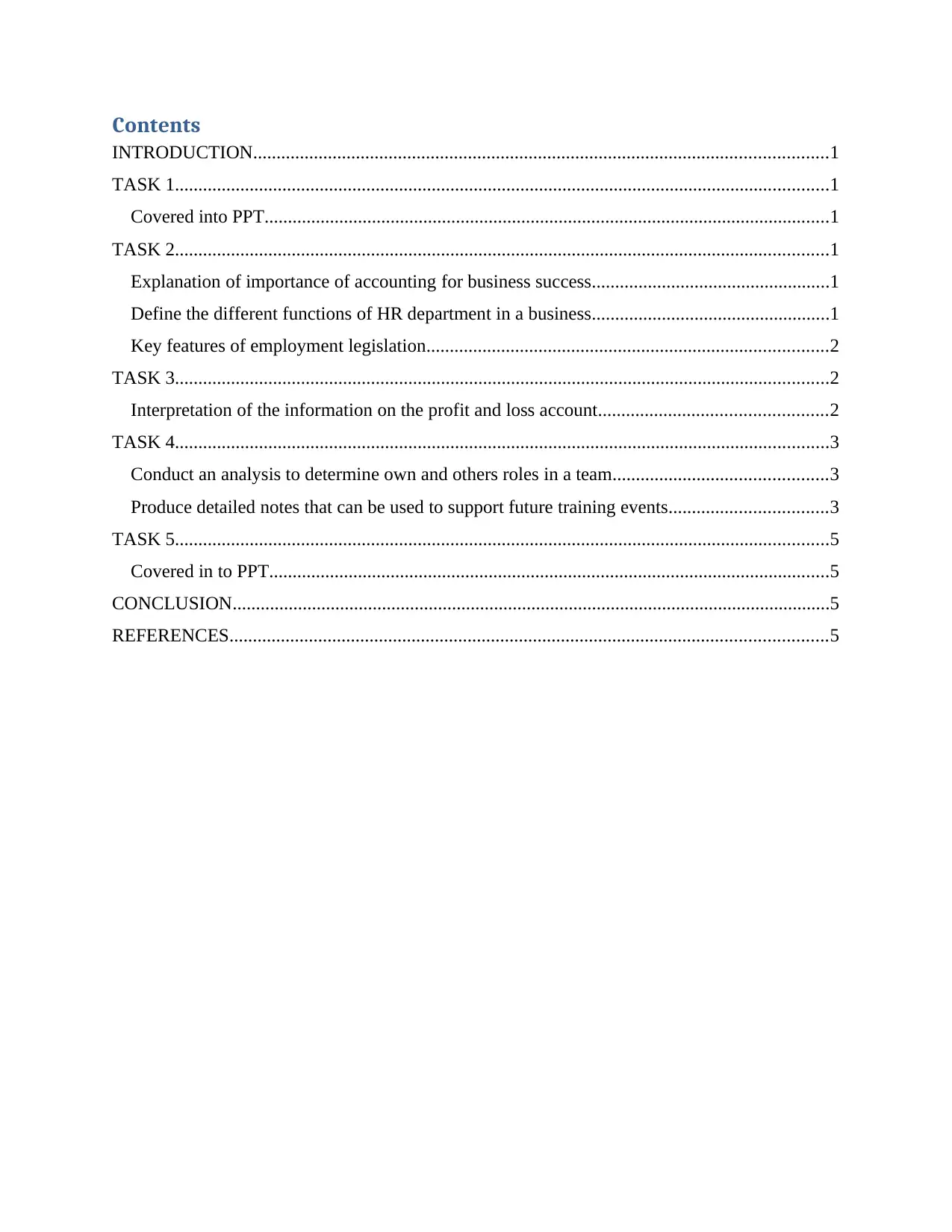
Contents
INTRODUCTION...........................................................................................................................1
TASK 1............................................................................................................................................1
Covered into PPT.........................................................................................................................1
TASK 2............................................................................................................................................1
Explanation of importance of accounting for business success...................................................1
Define the different functions of HR department in a business...................................................1
Key features of employment legislation......................................................................................2
TASK 3............................................................................................................................................2
Interpretation of the information on the profit and loss account.................................................2
TASK 4............................................................................................................................................3
Conduct an analysis to determine own and others roles in a team..............................................3
Produce detailed notes that can be used to support future training events..................................3
TASK 5............................................................................................................................................5
Covered in to PPT........................................................................................................................5
CONCLUSION................................................................................................................................5
REFERENCES................................................................................................................................5
INTRODUCTION...........................................................................................................................1
TASK 1............................................................................................................................................1
Covered into PPT.........................................................................................................................1
TASK 2............................................................................................................................................1
Explanation of importance of accounting for business success...................................................1
Define the different functions of HR department in a business...................................................1
Key features of employment legislation......................................................................................2
TASK 3............................................................................................................................................2
Interpretation of the information on the profit and loss account.................................................2
TASK 4............................................................................................................................................3
Conduct an analysis to determine own and others roles in a team..............................................3
Produce detailed notes that can be used to support future training events..................................3
TASK 5............................................................................................................................................5
Covered in to PPT........................................................................................................................5
CONCLUSION................................................................................................................................5
REFERENCES................................................................................................................................5
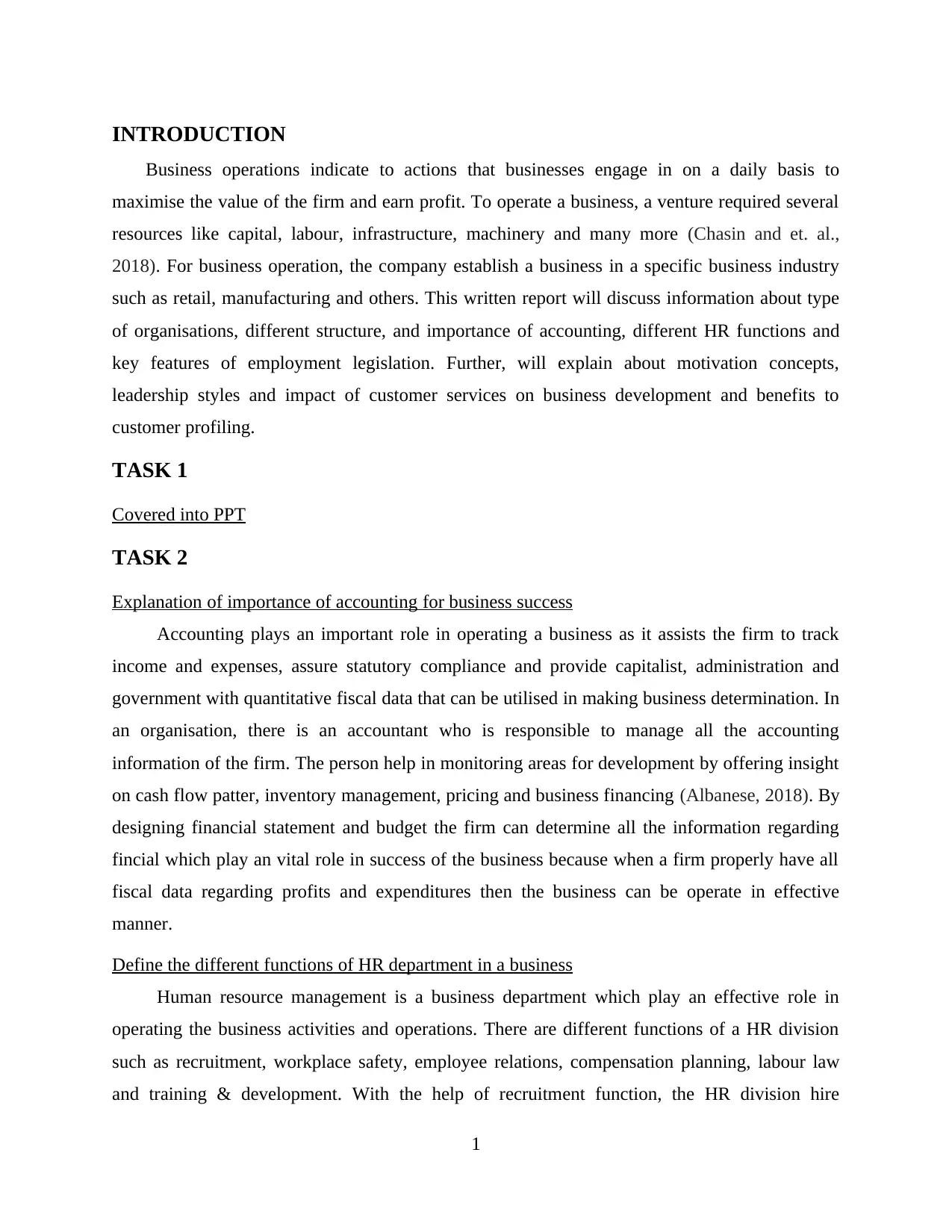
INTRODUCTION
Business operations indicate to actions that businesses engage in on a daily basis to
maximise the value of the firm and earn profit. To operate a business, a venture required several
resources like capital, labour, infrastructure, machinery and many more (Chasin and et. al.,
2018). For business operation, the company establish a business in a specific business industry
such as retail, manufacturing and others. This written report will discuss information about type
of organisations, different structure, and importance of accounting, different HR functions and
key features of employment legislation. Further, will explain about motivation concepts,
leadership styles and impact of customer services on business development and benefits to
customer profiling.
TASK 1
Covered into PPT
TASK 2
Explanation of importance of accounting for business success
Accounting plays an important role in operating a business as it assists the firm to track
income and expenses, assure statutory compliance and provide capitalist, administration and
government with quantitative fiscal data that can be utilised in making business determination. In
an organisation, there is an accountant who is responsible to manage all the accounting
information of the firm. The person help in monitoring areas for development by offering insight
on cash flow patter, inventory management, pricing and business financing (Albanese, 2018). By
designing financial statement and budget the firm can determine all the information regarding
fincial which play an vital role in success of the business because when a firm properly have all
fiscal data regarding profits and expenditures then the business can be operate in effective
manner.
Define the different functions of HR department in a business
Human resource management is a business department which play an effective role in
operating the business activities and operations. There are different functions of a HR division
such as recruitment, workplace safety, employee relations, compensation planning, labour law
and training & development. With the help of recruitment function, the HR division hire
1
Business operations indicate to actions that businesses engage in on a daily basis to
maximise the value of the firm and earn profit. To operate a business, a venture required several
resources like capital, labour, infrastructure, machinery and many more (Chasin and et. al.,
2018). For business operation, the company establish a business in a specific business industry
such as retail, manufacturing and others. This written report will discuss information about type
of organisations, different structure, and importance of accounting, different HR functions and
key features of employment legislation. Further, will explain about motivation concepts,
leadership styles and impact of customer services on business development and benefits to
customer profiling.
TASK 1
Covered into PPT
TASK 2
Explanation of importance of accounting for business success
Accounting plays an important role in operating a business as it assists the firm to track
income and expenses, assure statutory compliance and provide capitalist, administration and
government with quantitative fiscal data that can be utilised in making business determination. In
an organisation, there is an accountant who is responsible to manage all the accounting
information of the firm. The person help in monitoring areas for development by offering insight
on cash flow patter, inventory management, pricing and business financing (Albanese, 2018). By
designing financial statement and budget the firm can determine all the information regarding
fincial which play an vital role in success of the business because when a firm properly have all
fiscal data regarding profits and expenditures then the business can be operate in effective
manner.
Define the different functions of HR department in a business
Human resource management is a business department which play an effective role in
operating the business activities and operations. There are different functions of a HR division
such as recruitment, workplace safety, employee relations, compensation planning, labour law
and training & development. With the help of recruitment function, the HR division hire
1
⊘ This is a preview!⊘
Do you want full access?
Subscribe today to unlock all pages.

Trusted by 1+ million students worldwide
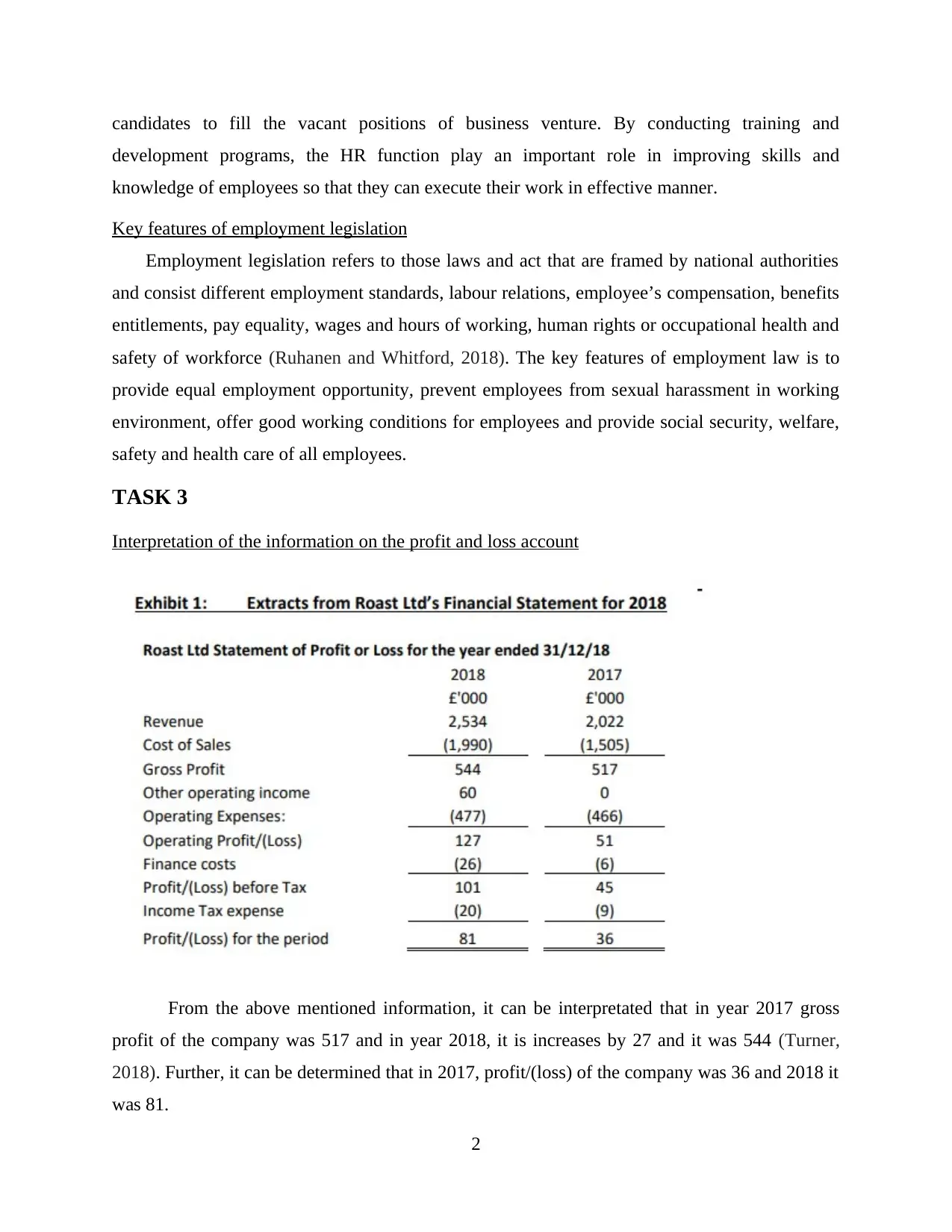
candidates to fill the vacant positions of business venture. By conducting training and
development programs, the HR function play an important role in improving skills and
knowledge of employees so that they can execute their work in effective manner.
Key features of employment legislation
Employment legislation refers to those laws and act that are framed by national authorities
and consist different employment standards, labour relations, employee’s compensation, benefits
entitlements, pay equality, wages and hours of working, human rights or occupational health and
safety of workforce (Ruhanen and Whitford, 2018). The key features of employment law is to
provide equal employment opportunity, prevent employees from sexual harassment in working
environment, offer good working conditions for employees and provide social security, welfare,
safety and health care of all employees.
TASK 3
Interpretation of the information on the profit and loss account
From the above mentioned information, it can be interpretated that in year 2017 gross
profit of the company was 517 and in year 2018, it is increases by 27 and it was 544 (Turner,
2018). Further, it can be determined that in 2017, profit/(loss) of the company was 36 and 2018 it
was 81.
2
development programs, the HR function play an important role in improving skills and
knowledge of employees so that they can execute their work in effective manner.
Key features of employment legislation
Employment legislation refers to those laws and act that are framed by national authorities
and consist different employment standards, labour relations, employee’s compensation, benefits
entitlements, pay equality, wages and hours of working, human rights or occupational health and
safety of workforce (Ruhanen and Whitford, 2018). The key features of employment law is to
provide equal employment opportunity, prevent employees from sexual harassment in working
environment, offer good working conditions for employees and provide social security, welfare,
safety and health care of all employees.
TASK 3
Interpretation of the information on the profit and loss account
From the above mentioned information, it can be interpretated that in year 2017 gross
profit of the company was 517 and in year 2018, it is increases by 27 and it was 544 (Turner,
2018). Further, it can be determined that in 2017, profit/(loss) of the company was 36 and 2018 it
was 81.
2
Paraphrase This Document
Need a fresh take? Get an instant paraphrase of this document with our AI Paraphraser

TASK 4
Conduct an analysis to determine own and others roles in a team
In a team each people of the group play and effective role to attain the objective of the task
regarding which a team is formed by the firm. For example, in an organisation, a group of 5
people is build by the management to increase the customer base of the firm by getting attention
of number of target audiences (Hernández-Perlines, Moreno-García and Yáñez-Araque, 2019).
In this, the individual is responsible to analyse the effective promotional tools that can be used
by the administration of respective firm to develop its customer base. Whereas remaining or
others are responsible to conduct survey to get information about effective promotional channels
etc.
Produce detailed notes that can be used to support future training events
Stages of team development
There are five phases of team development that can analysis with the help of Tuckman’s
team development concept. The description of this conception is as below:
Forming- It is the first phase of team development in which a business venture selected
skilled and knowledgeable person to form and build a team to perform a specific task and
accomplish the aims and goals of a particular business project.
Storming- It is next phase, in which all the team member start to know each other and
openly share ideas to perform the task and accomplish the common goals in effective and
efficient manner. In this phase conflicts arise among teammates.
Norming- In this stage, issues are resolved and employees adopt the concept of
teamwork. Group members make their effective contribution and start to trust each other. They
perform their assigned roles and responsibilities to attain task objective.
Performing- In performing phase, teammates are confident, encouraged and familiar
enough with the project and their group that they can operate without supervision. Each person is
on the same page and driving full speed ahead regarding the final goal.
Adjourning- It is the final phase of team development process and after accomplishing
the aim and goal of the task, the team is dissolved in this stage and the employees are rewarded
for the good performance (Blackburn, 2018). If some people are not do well then the firm
provide training and learning session to make development in their skills and knowledge.
3
Conduct an analysis to determine own and others roles in a team
In a team each people of the group play and effective role to attain the objective of the task
regarding which a team is formed by the firm. For example, in an organisation, a group of 5
people is build by the management to increase the customer base of the firm by getting attention
of number of target audiences (Hernández-Perlines, Moreno-García and Yáñez-Araque, 2019).
In this, the individual is responsible to analyse the effective promotional tools that can be used
by the administration of respective firm to develop its customer base. Whereas remaining or
others are responsible to conduct survey to get information about effective promotional channels
etc.
Produce detailed notes that can be used to support future training events
Stages of team development
There are five phases of team development that can analysis with the help of Tuckman’s
team development concept. The description of this conception is as below:
Forming- It is the first phase of team development in which a business venture selected
skilled and knowledgeable person to form and build a team to perform a specific task and
accomplish the aims and goals of a particular business project.
Storming- It is next phase, in which all the team member start to know each other and
openly share ideas to perform the task and accomplish the common goals in effective and
efficient manner. In this phase conflicts arise among teammates.
Norming- In this stage, issues are resolved and employees adopt the concept of
teamwork. Group members make their effective contribution and start to trust each other. They
perform their assigned roles and responsibilities to attain task objective.
Performing- In performing phase, teammates are confident, encouraged and familiar
enough with the project and their group that they can operate without supervision. Each person is
on the same page and driving full speed ahead regarding the final goal.
Adjourning- It is the final phase of team development process and after accomplishing
the aim and goal of the task, the team is dissolved in this stage and the employees are rewarded
for the good performance (Blackburn, 2018). If some people are not do well then the firm
provide training and learning session to make development in their skills and knowledge.
3
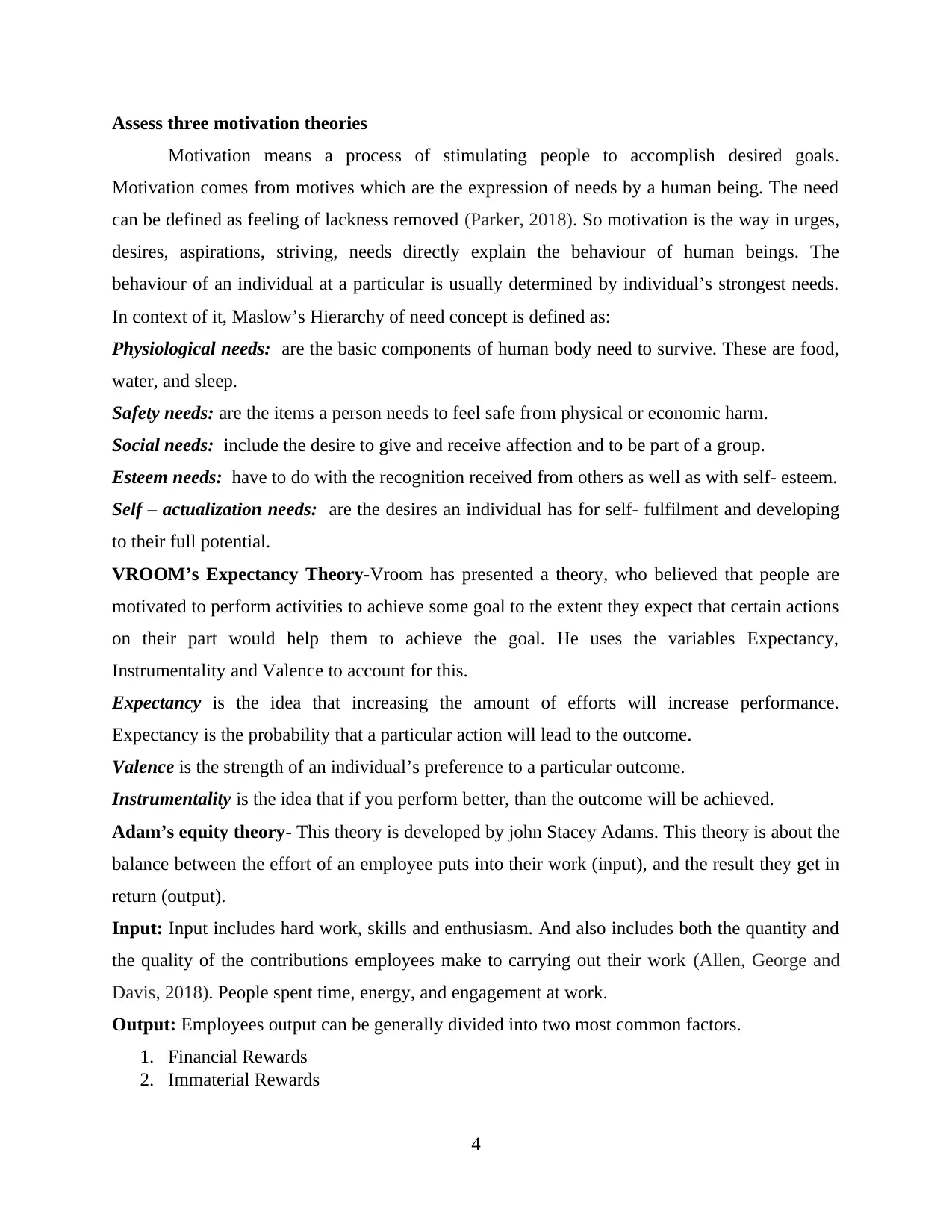
Assess three motivation theories
Motivation means a process of stimulating people to accomplish desired goals.
Motivation comes from motives which are the expression of needs by a human being. The need
can be defined as feeling of lackness removed (Parker, 2018). So motivation is the way in urges,
desires, aspirations, striving, needs directly explain the behaviour of human beings. The
behaviour of an individual at a particular is usually determined by individual’s strongest needs.
In context of it, Maslow’s Hierarchy of need concept is defined as:
Physiological needs: are the basic components of human body need to survive. These are food,
water, and sleep.
Safety needs: are the items a person needs to feel safe from physical or economic harm.
Social needs: include the desire to give and receive affection and to be part of a group.
Esteem needs: have to do with the recognition received from others as well as with self- esteem.
Self – actualization needs: are the desires an individual has for self- fulfilment and developing
to their full potential.
VROOM’s Expectancy Theory-Vroom has presented a theory, who believed that people are
motivated to perform activities to achieve some goal to the extent they expect that certain actions
on their part would help them to achieve the goal. He uses the variables Expectancy,
Instrumentality and Valence to account for this.
Expectancy is the idea that increasing the amount of efforts will increase performance.
Expectancy is the probability that a particular action will lead to the outcome.
Valence is the strength of an individual’s preference to a particular outcome.
Instrumentality is the idea that if you perform better, than the outcome will be achieved.
Adam’s equity theory- This theory is developed by john Stacey Adams. This theory is about the
balance between the effort of an employee puts into their work (input), and the result they get in
return (output).
Input: Input includes hard work, skills and enthusiasm. And also includes both the quantity and
the quality of the contributions employees make to carrying out their work (Allen, George and
Davis, 2018). People spent time, energy, and engagement at work.
Output: Employees output can be generally divided into two most common factors.
1. Financial Rewards
2. Immaterial Rewards
4
Motivation means a process of stimulating people to accomplish desired goals.
Motivation comes from motives which are the expression of needs by a human being. The need
can be defined as feeling of lackness removed (Parker, 2018). So motivation is the way in urges,
desires, aspirations, striving, needs directly explain the behaviour of human beings. The
behaviour of an individual at a particular is usually determined by individual’s strongest needs.
In context of it, Maslow’s Hierarchy of need concept is defined as:
Physiological needs: are the basic components of human body need to survive. These are food,
water, and sleep.
Safety needs: are the items a person needs to feel safe from physical or economic harm.
Social needs: include the desire to give and receive affection and to be part of a group.
Esteem needs: have to do with the recognition received from others as well as with self- esteem.
Self – actualization needs: are the desires an individual has for self- fulfilment and developing
to their full potential.
VROOM’s Expectancy Theory-Vroom has presented a theory, who believed that people are
motivated to perform activities to achieve some goal to the extent they expect that certain actions
on their part would help them to achieve the goal. He uses the variables Expectancy,
Instrumentality and Valence to account for this.
Expectancy is the idea that increasing the amount of efforts will increase performance.
Expectancy is the probability that a particular action will lead to the outcome.
Valence is the strength of an individual’s preference to a particular outcome.
Instrumentality is the idea that if you perform better, than the outcome will be achieved.
Adam’s equity theory- This theory is developed by john Stacey Adams. This theory is about the
balance between the effort of an employee puts into their work (input), and the result they get in
return (output).
Input: Input includes hard work, skills and enthusiasm. And also includes both the quantity and
the quality of the contributions employees make to carrying out their work (Allen, George and
Davis, 2018). People spent time, energy, and engagement at work.
Output: Employees output can be generally divided into two most common factors.
1. Financial Rewards
2. Immaterial Rewards
4
⊘ This is a preview!⊘
Do you want full access?
Subscribe today to unlock all pages.

Trusted by 1+ million students worldwide
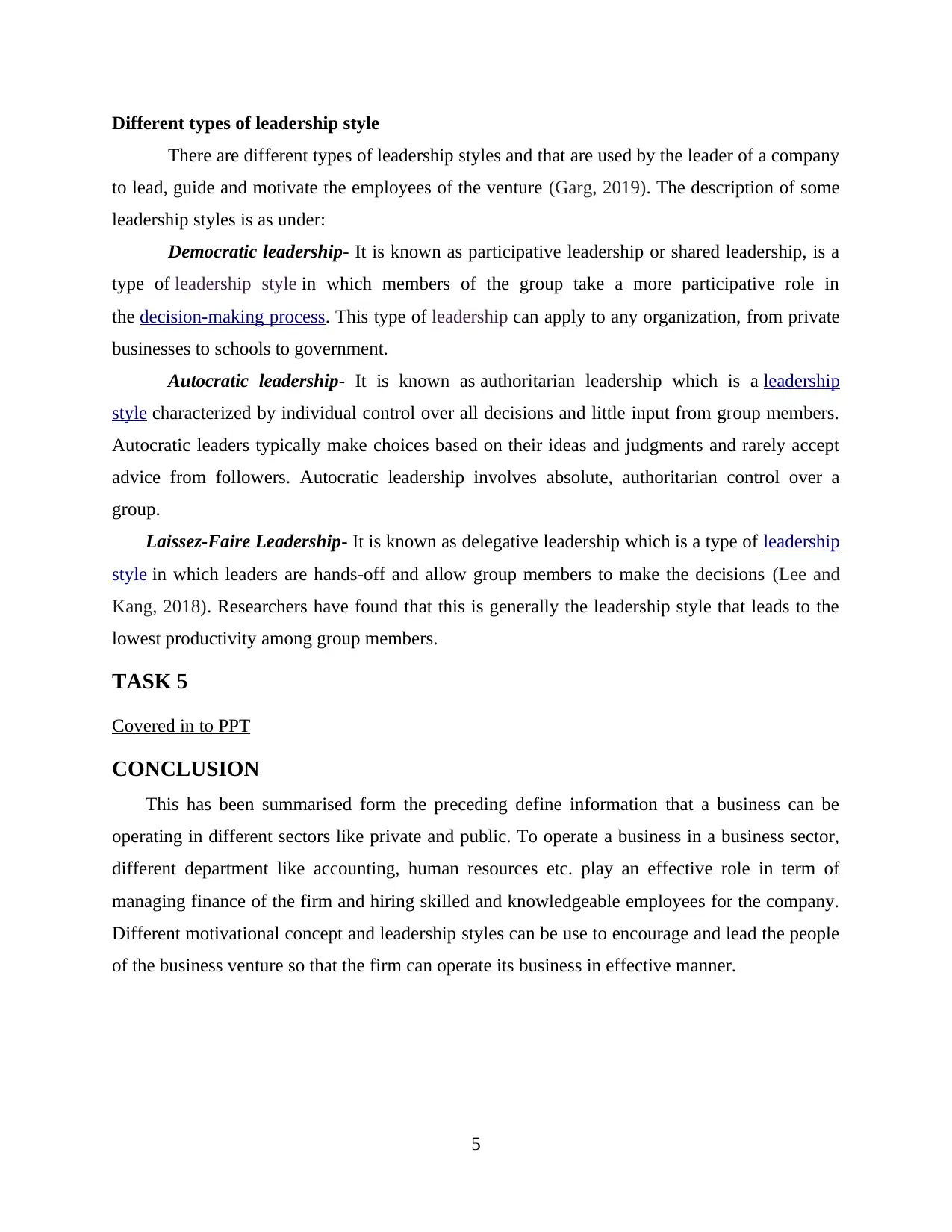
Different types of leadership style
There are different types of leadership styles and that are used by the leader of a company
to lead, guide and motivate the employees of the venture (Garg, 2019). The description of some
leadership styles is as under:
Democratic leadership- It is known as participative leadership or shared leadership, is a
type of leadership style in which members of the group take a more participative role in
the decision-making process. This type of leadership can apply to any organization, from private
businesses to schools to government.
Autocratic leadership- It is known as authoritarian leadership which is a leadership
style characterized by individual control over all decisions and little input from group members.
Autocratic leaders typically make choices based on their ideas and judgments and rarely accept
advice from followers. Autocratic leadership involves absolute, authoritarian control over a
group.
Laissez-Faire Leadership- It is known as delegative leadership which is a type of leadership
style in which leaders are hands-off and allow group members to make the decisions (Lee and
Kang, 2018). Researchers have found that this is generally the leadership style that leads to the
lowest productivity among group members.
TASK 5
Covered in to PPT
CONCLUSION
This has been summarised form the preceding define information that a business can be
operating in different sectors like private and public. To operate a business in a business sector,
different department like accounting, human resources etc. play an effective role in term of
managing finance of the firm and hiring skilled and knowledgeable employees for the company.
Different motivational concept and leadership styles can be use to encourage and lead the people
of the business venture so that the firm can operate its business in effective manner.
5
There are different types of leadership styles and that are used by the leader of a company
to lead, guide and motivate the employees of the venture (Garg, 2019). The description of some
leadership styles is as under:
Democratic leadership- It is known as participative leadership or shared leadership, is a
type of leadership style in which members of the group take a more participative role in
the decision-making process. This type of leadership can apply to any organization, from private
businesses to schools to government.
Autocratic leadership- It is known as authoritarian leadership which is a leadership
style characterized by individual control over all decisions and little input from group members.
Autocratic leaders typically make choices based on their ideas and judgments and rarely accept
advice from followers. Autocratic leadership involves absolute, authoritarian control over a
group.
Laissez-Faire Leadership- It is known as delegative leadership which is a type of leadership
style in which leaders are hands-off and allow group members to make the decisions (Lee and
Kang, 2018). Researchers have found that this is generally the leadership style that leads to the
lowest productivity among group members.
TASK 5
Covered in to PPT
CONCLUSION
This has been summarised form the preceding define information that a business can be
operating in different sectors like private and public. To operate a business in a business sector,
different department like accounting, human resources etc. play an effective role in term of
managing finance of the firm and hiring skilled and knowledgeable employees for the company.
Different motivational concept and leadership styles can be use to encourage and lead the people
of the business venture so that the firm can operate its business in effective manner.
5
Paraphrase This Document
Need a fresh take? Get an instant paraphrase of this document with our AI Paraphraser
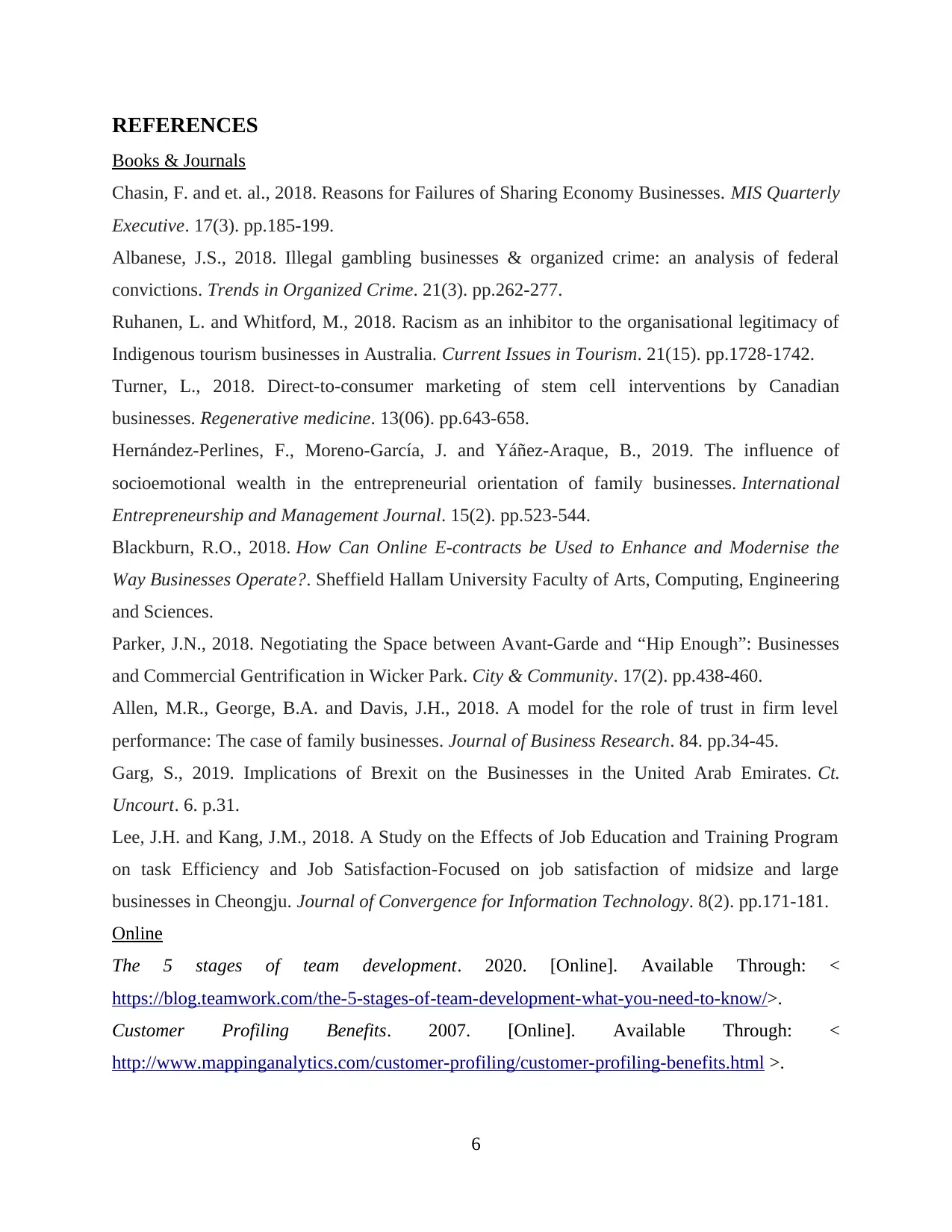
REFERENCES
Books & Journals
Chasin, F. and et. al., 2018. Reasons for Failures of Sharing Economy Businesses. MIS Quarterly
Executive. 17(3). pp.185-199.
Albanese, J.S., 2018. Illegal gambling businesses & organized crime: an analysis of federal
convictions. Trends in Organized Crime. 21(3). pp.262-277.
Ruhanen, L. and Whitford, M., 2018. Racism as an inhibitor to the organisational legitimacy of
Indigenous tourism businesses in Australia. Current Issues in Tourism. 21(15). pp.1728-1742.
Turner, L., 2018. Direct-to-consumer marketing of stem cell interventions by Canadian
businesses. Regenerative medicine. 13(06). pp.643-658.
Hernández-Perlines, F., Moreno-García, J. and Yáñez-Araque, B., 2019. The influence of
socioemotional wealth in the entrepreneurial orientation of family businesses. International
Entrepreneurship and Management Journal. 15(2). pp.523-544.
Blackburn, R.O., 2018. How Can Online E-contracts be Used to Enhance and Modernise the
Way Businesses Operate?. Sheffield Hallam University Faculty of Arts, Computing, Engineering
and Sciences.
Parker, J.N., 2018. Negotiating the Space between Avant‐Garde and “Hip Enough”: Businesses
and Commercial Gentrification in Wicker Park. City & Community. 17(2). pp.438-460.
Allen, M.R., George, B.A. and Davis, J.H., 2018. A model for the role of trust in firm level
performance: The case of family businesses. Journal of Business Research. 84. pp.34-45.
Garg, S., 2019. Implications of Brexit on the Businesses in the United Arab Emirates. Ct.
Uncourt. 6. p.31.
Lee, J.H. and Kang, J.M., 2018. A Study on the Effects of Job Education and Training Program
on task Efficiency and Job Satisfaction-Focused on job satisfaction of midsize and large
businesses in Cheongju. Journal of Convergence for Information Technology. 8(2). pp.171-181.
Online
The 5 stages of team development. 2020. [Online]. Available Through: <
https://blog.teamwork.com/the-5-stages-of-team-development-what-you-need-to-know/>.
Customer Profiling Benefits. 2007. [Online]. Available Through: <
http://www.mappinganalytics.com/customer-profiling/customer-profiling-benefits.html >.
6
Books & Journals
Chasin, F. and et. al., 2018. Reasons for Failures of Sharing Economy Businesses. MIS Quarterly
Executive. 17(3). pp.185-199.
Albanese, J.S., 2018. Illegal gambling businesses & organized crime: an analysis of federal
convictions. Trends in Organized Crime. 21(3). pp.262-277.
Ruhanen, L. and Whitford, M., 2018. Racism as an inhibitor to the organisational legitimacy of
Indigenous tourism businesses in Australia. Current Issues in Tourism. 21(15). pp.1728-1742.
Turner, L., 2018. Direct-to-consumer marketing of stem cell interventions by Canadian
businesses. Regenerative medicine. 13(06). pp.643-658.
Hernández-Perlines, F., Moreno-García, J. and Yáñez-Araque, B., 2019. The influence of
socioemotional wealth in the entrepreneurial orientation of family businesses. International
Entrepreneurship and Management Journal. 15(2). pp.523-544.
Blackburn, R.O., 2018. How Can Online E-contracts be Used to Enhance and Modernise the
Way Businesses Operate?. Sheffield Hallam University Faculty of Arts, Computing, Engineering
and Sciences.
Parker, J.N., 2018. Negotiating the Space between Avant‐Garde and “Hip Enough”: Businesses
and Commercial Gentrification in Wicker Park. City & Community. 17(2). pp.438-460.
Allen, M.R., George, B.A. and Davis, J.H., 2018. A model for the role of trust in firm level
performance: The case of family businesses. Journal of Business Research. 84. pp.34-45.
Garg, S., 2019. Implications of Brexit on the Businesses in the United Arab Emirates. Ct.
Uncourt. 6. p.31.
Lee, J.H. and Kang, J.M., 2018. A Study on the Effects of Job Education and Training Program
on task Efficiency and Job Satisfaction-Focused on job satisfaction of midsize and large
businesses in Cheongju. Journal of Convergence for Information Technology. 8(2). pp.171-181.
Online
The 5 stages of team development. 2020. [Online]. Available Through: <
https://blog.teamwork.com/the-5-stages-of-team-development-what-you-need-to-know/>.
Customer Profiling Benefits. 2007. [Online]. Available Through: <
http://www.mappinganalytics.com/customer-profiling/customer-profiling-benefits.html >.
6
1 out of 8
Related Documents
Your All-in-One AI-Powered Toolkit for Academic Success.
+13062052269
info@desklib.com
Available 24*7 on WhatsApp / Email
![[object Object]](/_next/static/media/star-bottom.7253800d.svg)
Unlock your academic potential
Copyright © 2020–2025 A2Z Services. All Rights Reserved. Developed and managed by ZUCOL.





